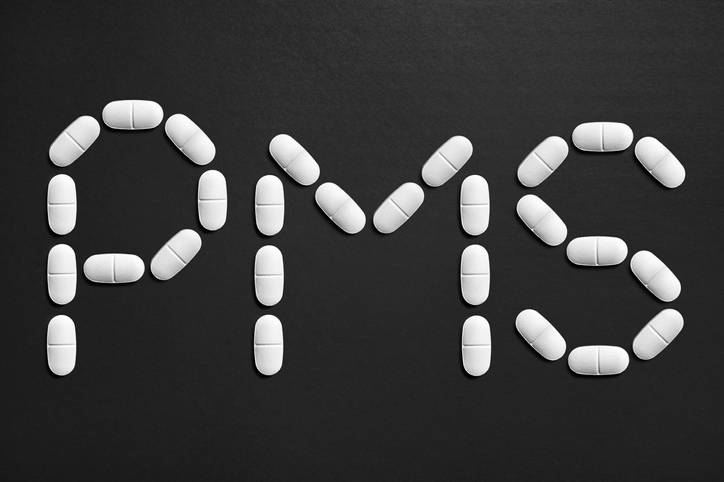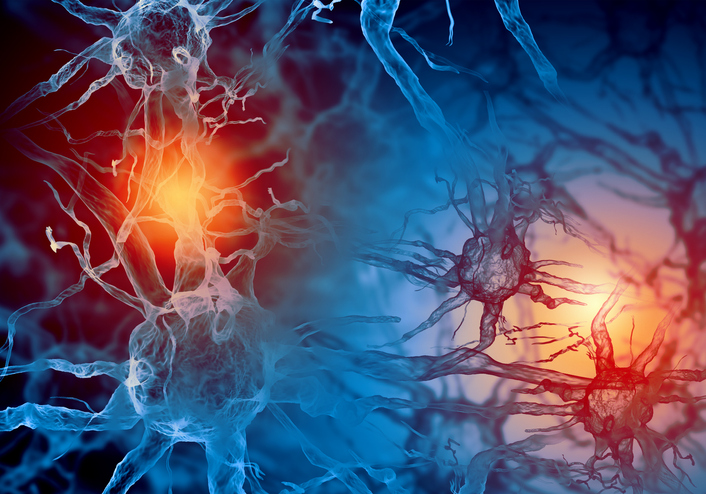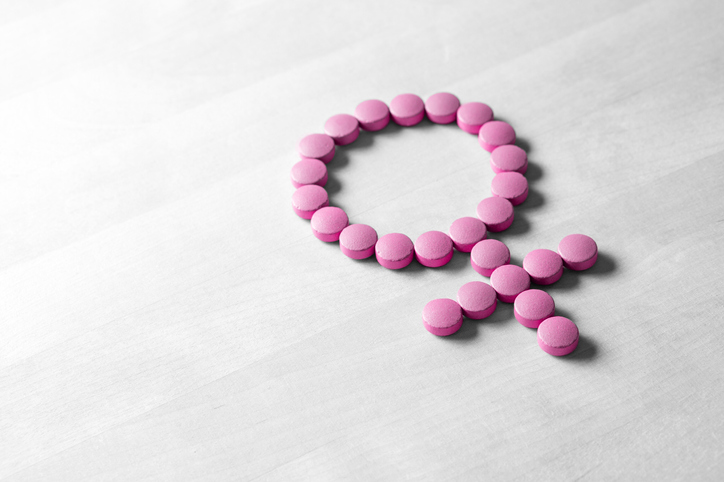by Dr Tony Coope
In PMS, A Doctor's View – Part 1, I set out a general classification of the four 'types' of PMS which showed some promise that we might be able to identify a cause for each set of symptoms. But it turns out that trying to work out the causes of PMS from even an organised list of the possible symptoms is rather like watching a blockbuster 3D movie without the special glasses; you have a general idea of what is going on, but the details are blurred, the colours run into each other, and clarity is tantalisingly out of reach!
However, a glance at the PMS-A/C/D/H categories I outlined in the previous article do suggest different factors and the influence of different hormones being involved in each type. For example:
(A) anxiety/hyperarousal (raised adrenaline and noradrenaline from the adrenal medulla)
(C) stress symptoms with secondary disturbance of sugar metabolism (raised adrenal cortical steroids, eg cortisol)
(D) depression, sadness and diminished mental function (increased oestrogen, reduced progesterone, raised cortisol)
(H) fluid retention and related signs and symptoms (increased oestrogen, aldosterone).
Although these categories seem relatively well defined, in practice there is considerable overlap between them. It becomes obvious that to pinpoint the complete hormonal state of affairs within an individual woman through laboratory tests would be very difficult in both practical and financial terms. Take into account the other hormones in the hormonal cascade, each with their different functions and subtle effects on mood and physical symptoms, and the scale of the problem becomes clear. No wonder we can still read in many publications that “PMS is a condition of unknown (or uncertain) origin”!
In her thoughtful book ‘The Truth about Hormones’, the science editor Vivienne Parry says “PMS is a classic model of the way hormones affect mood and emotion; it is also a fascinating model of fluctuating medical beliefs, swayed by prevailing medical dogma.” Here she is referring to theories of the cause of PMS which have tended to focus on hormone excess or deficiency, with either oestrogen or progesterone being given main responsibility.
I hope by now we can see that this is a much too simplistic approach, and that part of the answer must lie in the balance and fluctuation of the various hormones, fluctuations which of course have their own causes. Dr John Lee’s work on the syndrome of oestrogen dominance, with its ‘excess’ of oestrogen in relation to progesterone, is very much to the point here.
Much has been written in the psyche-soma debate in relation to PMS, just as it has about conditions such as chronic fatigue syndrome, prompting questions like “PMS – is it all in the mind?”, which have contributed to it not being given the importance it has deserved.
This bias has been based on the curious attitude that psychological and emotional disturbances somehow rate lower on the scale of things than physical ones. But the study of cellular biology, cell receptors and their informational substances (which include neurotransmitters and hormones too), has already shown us that our ideas of a separate mind and body are completely artificial, born of a polarised way of looking at the world.
There is only a bodymind, the different systems of which are in health completely integrated and communicating with each other at the cellular level through their extraordinary array of hormones, neurotransmitters and receptors. Because of a tendency to think in a compartmented, linear, cause-and-effect, ‘either-or’ sort of way, we often have difficulty in seeing the whole picture in complex conditions like PMS; whereas the truth is more likely to be glimpsed by a holistic, ‘both-and’ overview. For all its strengths, evidence-based medicine, with its emphasis on a reductionist approach, can contribute to this particular problem.
Taking this further, we know that, in the extreme, removal of the ovaries stops the symptoms of PMS. Symptoms also disappear in anovular cycles, where ovulation has, for whatever reason, not taken place. It has also been observed that if ovulation is artificially shut down with drugs the symptoms of PMS no longer arise. If these women are then given oestrogen and progesterone to restore previous levels, only the women who previously experienced symptoms do so again, showing that some women are especially sensitive to hormones, probably due to enhanced cell receptor sensitivity.
Another interesting fact: for women with mild PMS, the contraceptive pill, by stopping ovulation, eases symptoms; for those with more severe forms, their symptoms are made worse, probably due to the effect of the synthetic progestogens on women whose biochemistry is more severely disrupted by stress or previous emotional trauma. Exactly the same effect occurs in post-natal depression (PND), while in my experience bioidentical progesterone has a markedly beneficial effect in both conditions.
As if this is not enough to consider, there is the matter of the neurosteroids, steroids that are synthesized in the brain, and have marked effects on some of its own chemical systems. It is known that receptors on cell membranes in the brain that respond to oestrogen affect learning, memory and pain reception. In addition, low levels of the neurotransmitters GABA and serotonin are associated with violence and aggression; and of serotonin alone, with depression.
Interestingly, breakdown products of progesterone such as pregnenelone act as a calming influence, acting preferentially on the same receptors as do tranquillizers and barbiturates. We also know that low levels of the aminoacid tryptophan, a serotonin precursor, make PMS symptoms worse; that oestrogen tends to increase serotonin levels when given to menopausal women, as do drugs that promote serotonin release or prevent its reuptake, improving PMS.
Then there are the effects of diet, nutritional deficiencies, alcohol and obesity: a large subject in itself, and one I will touch on in my PMS – Part 3 article.
Finally, this brings us to the emotional aspect of PMS. The 3-5% of menstruating women who suffer from the severest symptoms find their day-to-day functioning significantly affected, with consequent problems for their families. The main symptoms in this group are primarily emotional, which is why psychiatrists have claimed it for their own and labelled it ‘Premenstrual Dysphoric Disorder’ or PMDD, the word ‘dysphoric’ meaning feelings at the opposite end of the spectrum from ‘euphoric’.
The emotional symptoms that stand out in this form of PMS are those that I have already described at the severe end of postnatal depression (PND); – anxiety, irritability, agitation, sudden panics; anger and aggressive outbursts, sometimes volcanic rages and violent behaviour, even feelings of murderous intent.
Another early advocate of natural progesterone supplementation, Dr Katherina Dalton, used to regularly visit Holloway women’s prison and found that very nearly half of all newly sentenced prisoners had committed their crimes during the four days before the start of menstruation and the first four days of the period itself. Bipolar swings similar to those in manic depression, and disconnection of thought and emotion as found in schizo-affective states, can also occur in the most extreme forms.
As we have seen, hormones do have their own direct effects on mood, but rather than taking the easy route and attributing these symptoms to a particular combination of hormones, I think that it is much more likely that, as in PND and puerperal psychosis, it is the fluctuation of the hormonal picture that allows the release of feelings that are already there, repressed and stored away within the body in response to previous traumas, sometimes physical or sexual, often emotional, that could not be expressed at the time, or resolved since.
The majority of these are from childhood, but their repression seems to attract in later life the very situations which will trigger the same feelings, leading to the recurring negative ‘patterns’ of experience with which all too many of us are familiar.
The positive aspect of this suffering, however, is that it sooner or later forces us to explore or confront the hidden emotional issues that underlie PMS, which itself may act both as a reminder and as a pressure-release valve. There is a saying I like:- ‘Give me the courage to meet the Devil in his lair, and make of him a friend’. The process of healing these emotional and psychological stresses means that these energies are then no longer present to ‘break through’ when hormonal fluctuations occur.
Dr Christiane Northrup in her comprehensive guide to women’s health ‘Women’s Bodies, Women’s Wisdom’ writes well on this sensitive subject. She also describes a strong correlation between PMS and growing up in a family system in which parents or even grandparents were alcoholic. “The relationship between PMS and relationship addiction – giving your life away to meet other people’s needs – is very high” she says.
It is not difficult to see here the seeds of co-dependency. The intense, confusing and contradictory emotions of love, hate, anger, guilt, despair, shame, fear and defeat experienced in response by many children in this situation cannot be borne consciously for long.
The result is a cutting off from their feelings, which resurface later in life at particularly vulnerable times. These may be times of severe or cumulative stress, emotional or physical exhaustion; or at times of hormonal imbalance or fluctuation, such as in the postnatal and premenstrual phases, and to a lesser degree at the menopause.
It is not always easy, and sometimes not possible, to explore the underlying issues in these situations, but in my own experience, if a woman has the willingness and the courage to do so, the results are almost always beneficial.
In PMS, A Doctor's View – Part 3 I’ll explore the different levels of approach available to help resolve this condition, and hope to set out a coherent and comprehensive way of looking at the problem.
- - - - - - - - - -
Dr Tony Coope has over twenty years experience in General Practice, prior to which he spent four years as a hospital doctor, covering the specialities of medicine, surgery, paediatrics, geriatrics and emergency/trauma medicine.
In the early 1990’s he left general practice to explore an Integrated Medical approach including the use of nutritional supplements, bioidentical hormones and botanicals.
In PMS, A Doctor's View – Part 1, I set out a general classification of the four 'types' of PMS which showed some promise that we might be able to identify a cause for each set of symptoms. But it turns out that trying to work out the causes of PMS from even an organised list of the possible symptoms is rather like watching a blockbuster 3D movie without the special glasses; you have a general idea of what is going on, but the details are blurred, the colours run into each other, and clarity is tantalisingly out of reach!
However, a glance at the PMS-A/C/D/H categories I outlined in the previous article do suggest different factors and the influence of different hormones being involved in each type. For example:
(A) anxiety/hyperarousal (raised adrenaline and noradrenaline from the adrenal medulla)
(C) stress symptoms with secondary disturbance of sugar metabolism (raised adrenal cortical steroids, eg cortisol)
(D) depression, sadness and diminished mental function (increased oestrogen, reduced progesterone, raised cortisol)
(H) fluid retention and related signs and symptoms (increased oestrogen, aldosterone).
Although these categories seem relatively well defined, in practice there is considerable overlap between them. It becomes obvious that to pinpoint the complete hormonal state of affairs within an individual woman through laboratory tests would be very difficult in both practical and financial terms. Take into account the other hormones in the hormonal cascade, each with their different functions and subtle effects on mood and physical symptoms, and the scale of the problem becomes clear. No wonder we can still read in many publications that “PMS is a condition of unknown (or uncertain) origin”!
In her thoughtful book ‘The Truth about Hormones’, the science editor Vivienne Parry says “PMS is a classic model of the way hormones affect mood and emotion; it is also a fascinating model of fluctuating medical beliefs, swayed by prevailing medical dogma.” Here she is referring to theories of the cause of PMS which have tended to focus on hormone excess or deficiency, with either oestrogen or progesterone being given main responsibility.
I hope by now we can see that this is a much too simplistic approach, and that part of the answer must lie in the balance and fluctuation of the various hormones, fluctuations which of course have their own causes. Dr John Lee’s work on the syndrome of oestrogen dominance, with its ‘excess’ of oestrogen in relation to progesterone, is very much to the point here.
Much has been written in the psyche-soma debate in relation to PMS, just as it has about conditions such as chronic fatigue syndrome, prompting questions like “PMS – is it all in the mind?”, which have contributed to it not being given the importance it has deserved.
This bias has been based on the curious attitude that psychological and emotional disturbances somehow rate lower on the scale of things than physical ones. But the study of cellular biology, cell receptors and their informational substances (which include neurotransmitters and hormones too), has already shown us that our ideas of a separate mind and body are completely artificial, born of a polarised way of looking at the world.
There is only a bodymind, the different systems of which are in health completely integrated and communicating with each other at the cellular level through their extraordinary array of hormones, neurotransmitters and receptors. Because of a tendency to think in a compartmented, linear, cause-and-effect, ‘either-or’ sort of way, we often have difficulty in seeing the whole picture in complex conditions like PMS; whereas the truth is more likely to be glimpsed by a holistic, ‘both-and’ overview. For all its strengths, evidence-based medicine, with its emphasis on a reductionist approach, can contribute to this particular problem.
Taking this further, we know that, in the extreme, removal of the ovaries stops the symptoms of PMS. Symptoms also disappear in anovular cycles, where ovulation has, for whatever reason, not taken place. It has also been observed that if ovulation is artificially shut down with drugs the symptoms of PMS no longer arise. If these women are then given oestrogen and progesterone to restore previous levels, only the women who previously experienced symptoms do so again, showing that some women are especially sensitive to hormones, probably due to enhanced cell receptor sensitivity.
Another interesting fact: for women with mild PMS, the contraceptive pill, by stopping ovulation, eases symptoms; for those with more severe forms, their symptoms are made worse, probably due to the effect of the synthetic progestogens on women whose biochemistry is more severely disrupted by stress or previous emotional trauma. Exactly the same effect occurs in post-natal depression (PND), while in my experience bioidentical progesterone has a markedly beneficial effect in both conditions.
As if this is not enough to consider, there is the matter of the neurosteroids, steroids that are synthesized in the brain, and have marked effects on some of its own chemical systems. It is known that receptors on cell membranes in the brain that respond to oestrogen affect learning, memory and pain reception. In addition, low levels of the neurotransmitters GABA and serotonin are associated with violence and aggression; and of serotonin alone, with depression.
Interestingly, breakdown products of progesterone such as pregnenelone act as a calming influence, acting preferentially on the same receptors as do tranquillizers and barbiturates. We also know that low levels of the aminoacid tryptophan, a serotonin precursor, make PMS symptoms worse; that oestrogen tends to increase serotonin levels when given to menopausal women, as do drugs that promote serotonin release or prevent its reuptake, improving PMS.
Then there are the effects of diet, nutritional deficiencies, alcohol and obesity: a large subject in itself, and one I will touch on in my PMS – Part 3 article.
Finally, this brings us to the emotional aspect of PMS. The 3-5% of menstruating women who suffer from the severest symptoms find their day-to-day functioning significantly affected, with consequent problems for their families. The main symptoms in this group are primarily emotional, which is why psychiatrists have claimed it for their own and labelled it ‘Premenstrual Dysphoric Disorder’ or PMDD, the word ‘dysphoric’ meaning feelings at the opposite end of the spectrum from ‘euphoric’.
The emotional symptoms that stand out in this form of PMS are those that I have already described at the severe end of postnatal depression (PND); – anxiety, irritability, agitation, sudden panics; anger and aggressive outbursts, sometimes volcanic rages and violent behaviour, even feelings of murderous intent.
Another early advocate of natural progesterone supplementation, Dr Katherina Dalton, used to regularly visit Holloway women’s prison and found that very nearly half of all newly sentenced prisoners had committed their crimes during the four days before the start of menstruation and the first four days of the period itself. Bipolar swings similar to those in manic depression, and disconnection of thought and emotion as found in schizo-affective states, can also occur in the most extreme forms.
As we have seen, hormones do have their own direct effects on mood, but rather than taking the easy route and attributing these symptoms to a particular combination of hormones, I think that it is much more likely that, as in PND and puerperal psychosis, it is the fluctuation of the hormonal picture that allows the release of feelings that are already there, repressed and stored away within the body in response to previous traumas, sometimes physical or sexual, often emotional, that could not be expressed at the time, or resolved since.
The majority of these are from childhood, but their repression seems to attract in later life the very situations which will trigger the same feelings, leading to the recurring negative ‘patterns’ of experience with which all too many of us are familiar.
The positive aspect of this suffering, however, is that it sooner or later forces us to explore or confront the hidden emotional issues that underlie PMS, which itself may act both as a reminder and as a pressure-release valve. There is a saying I like:- ‘Give me the courage to meet the Devil in his lair, and make of him a friend’. The process of healing these emotional and psychological stresses means that these energies are then no longer present to ‘break through’ when hormonal fluctuations occur.
Dr Christiane Northrup in her comprehensive guide to women’s health ‘Women’s Bodies, Women’s Wisdom’ writes well on this sensitive subject. She also describes a strong correlation between PMS and growing up in a family system in which parents or even grandparents were alcoholic. “The relationship between PMS and relationship addiction – giving your life away to meet other people’s needs – is very high” she says.
It is not difficult to see here the seeds of co-dependency. The intense, confusing and contradictory emotions of love, hate, anger, guilt, despair, shame, fear and defeat experienced in response by many children in this situation cannot be borne consciously for long.
The result is a cutting off from their feelings, which resurface later in life at particularly vulnerable times. These may be times of severe or cumulative stress, emotional or physical exhaustion; or at times of hormonal imbalance or fluctuation, such as in the postnatal and premenstrual phases, and to a lesser degree at the menopause.
It is not always easy, and sometimes not possible, to explore the underlying issues in these situations, but in my own experience, if a woman has the willingness and the courage to do so, the results are almost always beneficial.
In PMS, A Doctor's View – Part 3 I’ll explore the different levels of approach available to help resolve this condition, and hope to set out a coherent and comprehensive way of looking at the problem.
- - - - - - - - - -
Dr Tony Coope has over twenty years experience in General Practice, prior to which he spent four years as a hospital doctor, covering the specialities of medicine, surgery, paediatrics, geriatrics and emergency/trauma medicine.
In the early 1990’s he left general practice to explore an Integrated Medical approach including the use of nutritional supplements, bioidentical hormones and botanicals.
* This information is for general interest only. Every woman is unique. Your results may vary.
PMS encompasses a huge range of symptoms - and potential treatments. But some treatments are more successful than others.
Based on the foundation of enhancing natural progesterone, this 3 step plan could be a complete solution for PMS problems
Hear what doctors have to say about natural progesterone and its benefits
Based on the foundation of enhancing natural progesterone, this 3 step plan could be a complete solution for PMS problems
Over 35? Then you could still be at risk of PMS and those symptoms you thought you had left behind long ago
PMS responds very well to progesterone, but there are a few more things that can enhance your response and make a real difference
What exactly is Premenstrual Syndrome and how can you recognise its symptoms?
The causes and effects of PMS can be more complex and interrelated than mainstream medicine allows for.
In the third part of his series on PMS, Dr Coope looks at the treatments available for symptoms relief
In the fourth and final part of his series on PMS Dr Coope discusses the deeper and more gentle holistic approaches to symptoms relief
All information given on this site is for general interest only. Every woman is unique. Your results may vary.









































